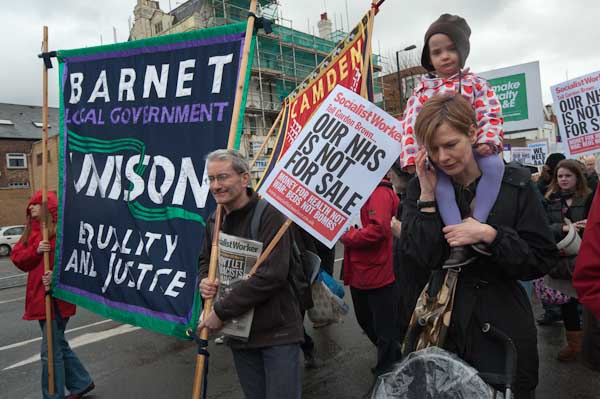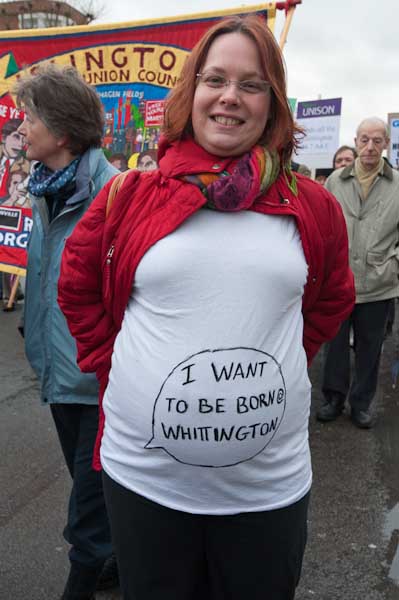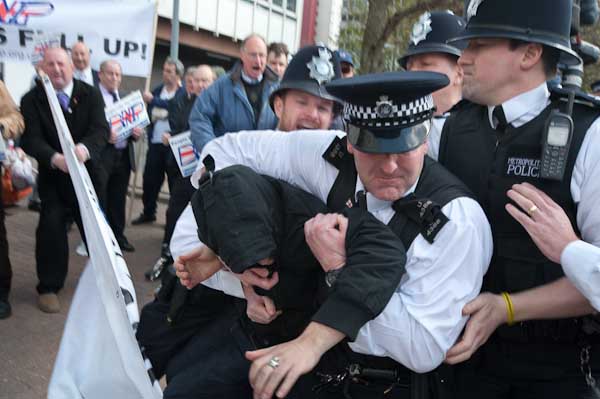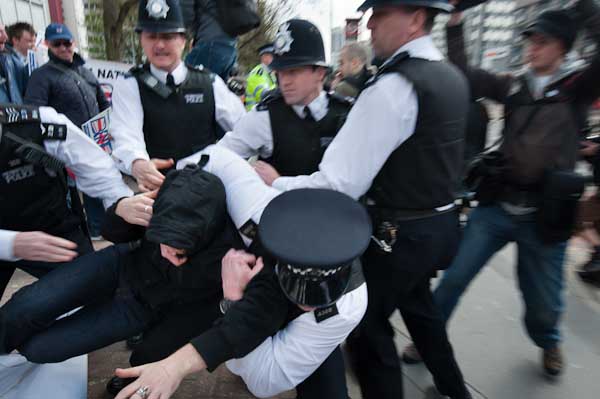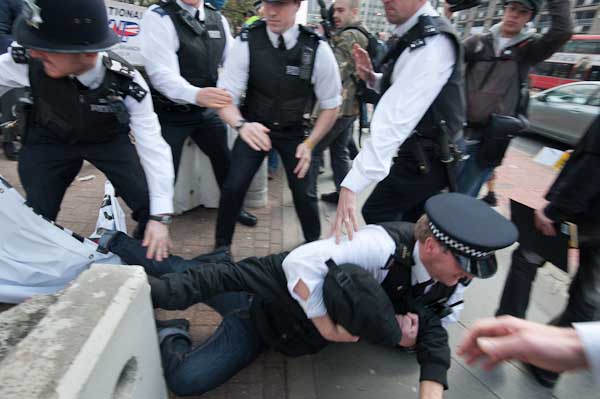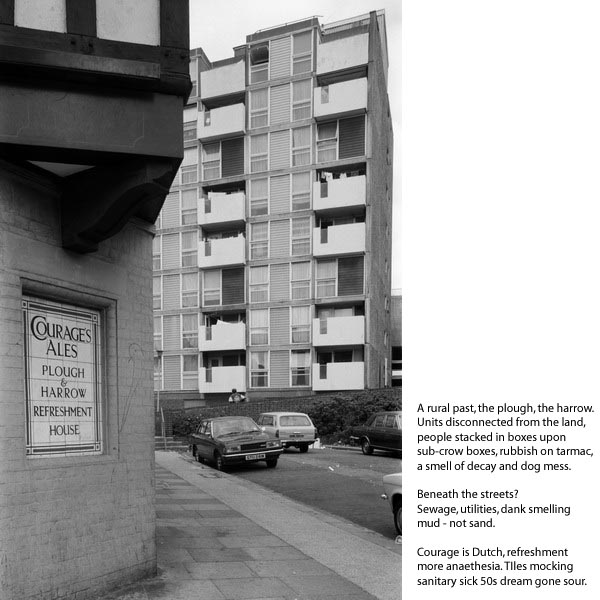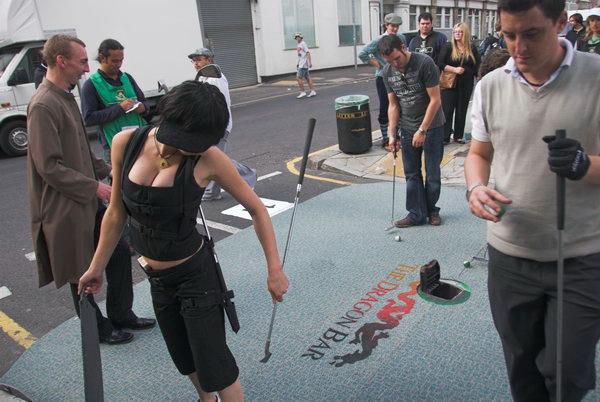I’m not quite sure why the panel discussion at last Saturday’s ‘The Invisible City‘ got on to a discussion about the relative merits of digital and film. But for whatever reason, it did seem to me that various people were talking nonsense about the subject, and it would appear that rather a lot of students are being indoctrinated with it on their courses.
I think there are still quite a few photographers – particularly in academic circles – who have failed to come to terms with digital as a part of a more general antagonism and lack of knowledge about computing. I worked for some years as an IT co-ordinator and network manager in a college and learnt a great deal about the kind of resistance some have to computers and IT in general.
There are still some particular niches of photography where I would prefer to use film, although it often isn’t practicable to do so. These are mainly areas which require the use of specialist equipment which simply isn’t available – or not at any reasonable cost – as digital. Quite where that cost barrier lies will depend on how wealthy you are, and some may consider the Leica M9 a viable alternative to a M-series film camera, while I can’t bring myself to spend the cash.
However it is very hard to find a good reason to use a film SLR in preference to a digital version – with excellent cameras available for relatively small sums – the cost of a few months film for a serious student.
Though I’m not sure how many are serious students – in the old days to be serious you shot a 100 foot can of bulk Tri-X a month, which I think worked out at 19 x 36 exposure films (and if you were really keen you learnt to load them from a daylight bulk loader but in the dark so as to avoid any fogging on the end of the film. A little under 700 exposures – less than I now take on digital on a busy day.
Which perhaps leads us to
Myth No 1:
Digital makes you work in a different way, being less critical when you are working because you are limited in how many exposures you can make.
It isn’t true, and I know photographers who shoot just they way they used to on film. I think they are missing out on things, because digital does open up new possibilities. It gives you the choice of working in a different way, but you don’t have to if you really don’t want to.
Looking through my contact sheets and comparing them with my digital exposures, I don’t think I’m less critical. I am rather more prepared to take risks, but overall I think digital has rather improved the quality of my work, both technically and in terms of being able to achieve various things that just were not possible on film. It provides a much more reliable system than film ever did, in almost every respect.
Digital actually provides a much greater opportunity to be critical while you are actually working, although I’m not a great “chimper“, as I find it disrupts my attention to the subject. But being able to review your work immediately afterwards is a great advance, and with some kinds of subject it is possible to evaluate and retake pictures on the spot.
There are even some particular subjects where I take less images using digital, especially portraits. On film you could never be sure whether you had actually captured that fleeting gesture or if your subject had managed to blink in the critical fraction of a second. If I could, I kept shooting until I was fairly sure I had got the picture; with digital you can check and stop shooting when you know you have what you want.
Working with digital I simply end up with more good pictures. For a typical event where film might have given me half a dozen decent frames from which to select, with digital I may end up with 50 from which to choose. Probably these would include the pictures I would have got on film, but they no longer stand out in quite the same way as the dross gets deleted.
Myth No 2:
Film gives you better quality than digital
I almost choked when I heard this. I often need to scan older work and have one of the best systems available for scanning 35mm film to give 80Mb scans, which can really squeeze the last ounce out of film. Quality is a rather subjective concept, but given an image from the D700 taken at a similar ISO, I would expect greater resolution, greater sharpness and less noise from the digital image.
So far as colour quality goes, there is just no comparison – digital colour is so much cleaner and more accurate than film ever managed (so long as you don’t allow camera or computer to mess it up.) You may of course prefer the rather more limited and less real palette of film – and can if you wish use software to emulate it on your digital images. If your idea of quality is a retro look, then you might prefer film.
Black and white film normally does have a greater dynamic range than current digital sensors, although the difference is less pronounced once you have learnt to make use of raw images. And since digital is then able to cope with most subjects (and makes the use of fill flash even easier than on film with modern cameras) this is seldom a vital matter.
The only films that approach the quality of digital sensors of the same format are those extremely slow black and white films that were largely not designed for pictorial use – such as the no longer available Kodak Technical Pan, which I did use quite extensively. It wasn’t an easy film to use and required exposure at rather silly ISOs – from ISO8 to ISO64 depending on developer for pictorial negatives.
Kodachrome with its own peculiar colours was also available as an ISO 25 film, and could possibly compete with results from digital at 3 or 4 stops faster speeds were it still available, although – like Technical Pan – it could not match their dynamic range.
Of course film is available in different formats, and the kind of quality that I currently get at moderate ISOs from the D700 certainly seems to me to compare well with that I got from the Mamiya 6×7 I used to use. With the great advantage that I can continue to get similar quality at much higher ISOs than with film.
Myth No 3
Film is better for storage than digital
Both film and digital present some problems for storage. But unless you happen to own a deep mine digital is probably the better bet. Digital storage can theoretically keep your images perfect forever – but only if you set up systems with suitable redundancy and regeneration of files. Film storage is more clearly time-limited, but low-tech to give decent short and medium term safety.
My perspective on this problem is perhaps slightly coloured by the rows of slowly deteriorating negative files behind me as I type. But perhaps the most interesting and authoritative comment on this was made by Mike Seaborne from his position as a museum curator who obviously surprised some of the audience when he said that the best long-term storage is as pigment inkjet prints on well-made paper, fortunately something we can do for both film and digital images.
Myth No 4:
You need to shoot film if you want to work in black and white
Much of the best black and white work I’ve seen published in recent years has been shot on digital. Although personally I decided to shoot entirely in colour with digital in 2002 when I bought my first DSLR, I know plenty of other photographers who have gone digital with the intention of shooting black and white.
Apart from all the usual advantages of digital, one important one for working in black and white is the ability to actually see your images on the back of the camera in black and white, although the conversion in camera is relatively crude.
Over the years I used quite a few different black and white films, including of course FP4 and Tri-X, but also many less popular films, most no longer available. In later years I worked mainly with chromogenic films – XP1 and 2 and TCN400 largely because it was easier to process them with my colour film. Each of these films had its own particular ‘look’, largely a matter of different sensitivity to different light wavelengths. But with software such as Lightroom, not only do you have the possibility of emulating these different responses, but also you can vary the sensitivity in a much wider and complex way should you wish. As in most respects, digital offers greater flexibility.
What might at some point attract me is however the ability to get decent quality results in light levels where film would have needed excessive “pushing” with the accompanying grain and loss of subtlety. Even a relatively crude digital camera like the Leica M8 can produce pretty good black and white at ISO 1250, while the D700 is rather better at ISO6400.
Myth No 5
Inkjet prints can’t match the quality of darkroom prints
I haven’t made a print in my darkroom for several years. But there is a certain undercurrent of truth in ‘Myth No 5’, and there are many bad inkjet prints made. But there are also many bad darkroom prints.
But you cannot buy a darkroom paper that is not capable of producing a halfway decent print, when only too many people are happy to print pictures on inkjet with materials that were not produced and are certainly not fit for that purpose.
Good inkjet prints need good paper and good inks. I first started making them using Cone Piezography black and white inks on Hahnemühle papers ten years ago – and the latest Piezography K7 inks (which I haven’t used) are the best available solution for matte prints. The prints I made were so good I abandoned for good any ideas of going back to make platinum prints.
Replacing ‘glossy’ prints took longer, but the Epson ABW system using Epson Ultrachrome K3 pigment inks on papers such as Ilford Gold Fibre Silk or PermaJet Classic Fine Art gives results that for 9 prints out of 10 are better than my old darkroom prints. The only ones that are really hard to beat were made on a paper that is no longer available, the old cadmium-rich Record Rapid, which had a greater depth than modern papers. Some of these new fibre base glossy papers have a very similar ‘baryta’ coating to silver halide papers.
Printing digitally actually needs the same basic skill as darkroom printing – deciding how a picture should look. But on the computer it is rather easier to achieve, and ‘dodging’ and ‘burning’ can be carried out with more control and precision. Most images too need a certain amount of corrective retouching to correct defects such as dust and scratches on negatives or dust on the sensor. Increasingly my film images also need retouching to repair the ravages of time, and digital printing becomes the only option.
Of course inkjet printers and materials will be improved, but already they can hold their own against the darkroom, both for colour (which is where most of the printer manufacturers’ efforts are directed) and also – especially with the aid of third-party inks and papers – for black and white.
Further Thoughts
Were I still teaching photography, I would be concentrating on the use of digital photography. Not only because I think it in almost every respect improves on film and is the future of our medium, but because I think it is a very much better teaching tool, because of the more or less immediate feedback it can give.
Years ago, when still teaching darkroom printing, I found it worth teaching students the basics of working with digital images with Photoshop before getting them to make prints in the darkroom. Before you can print well, you have to learn what good prints look like, and get some idea of what can be done with the various controls that we have – exposure, contrast, burning, dodging – and it is easier, faster and considerably cheaper to get learners to appreciate these in the darkroom once they have experienced them on a computer. Now of course there is no need for the darkroom, although they can still learn on screen before wasting ink and paper on the print.
Alternative Processes
Silver based photography is fast becoming another alternative process – like making collodion negatives (in some ways the apex of photography) and cyanotypes or gum bichromate prints. Of course there will be students who want to learn and practice these things (and I’ve tried most of them), but they are neither necessary or generally useful for photographers, although they do help in the appreciation of the history and traditions of photography.
